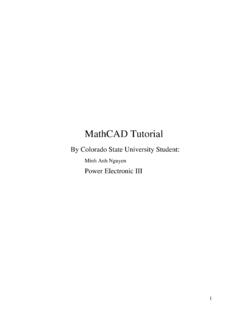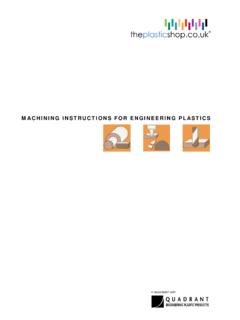Transcription of C F Braun - An Alhambra Institution
1 C F Braun - An Alhambra Institution By Gary Frueholz, Dilbeck Real Estate Historically, Alhambra had a sizeable industrial base of civil engineering corporations in its southwest section. Companies that resided there included the Vinnell Corporation and the Alhambra Foundry. Vinnell gained a place in Southern California lore by being the prime contractor for Dodger Stadium and doing numerous international civil engineering projects. The Alhambra Foundry specialized in metal works and produced items such as man hole covers bearing their name which can still be seen throughout the streets of Southern California. I can remember as a young boy peering into the Alhambra Foundry and seeing molten metal being poured with sparks flying in all directions. Another internationally known company that called Alhambra home was C F Braun & Company.
2 Located at the corner of Fremont Avenue and Mission Road, C F Braun & Company was one of the most formidable petrochemical engineering companies in the world during the post World War II period. During the 1950's C F Braun would employ over six thousand employees and have annual business revenues exceeding $100 million. And by this time C F Braun had constructed over 250 chemical and industrial complexes throughout the world. The company reflected the personality of its founder and leader, Carl Braun in its thorough and organized approach to business and its unique corporate culture. Carl Franklin Braun graduated from Stanford University in 1907 with a degree in mechanical engineering . After two years of working as an manufacturer's agent, Braun started his own engineering and manufacturing company with $500.
3 It was located in San Francisco and specialized in hydraulic valves, water pumps, water treatment filters, and condensers. Braun 's products were used in office buildings, power plants, oil refineries, and ships at a time when the world saw Industrial America on the march. Characteristic of Braun 's hands on leadership style, the early C F Braun & Company in San Francisco had one and only one salesman; Carl F. Braun . With the signing of the Armistice in 1918 marking the end of World War I, C F Braun & Company saw a dramatic decline in contracts for manufactured ship components. Rather than retrenching, Braun saw an opportunity in a new world of exploration, petroleum processing plants. Realizing a potential in this market that few others fully appreciated, Braun knew his company needed to dramatically expand.
4 And it needed to expand in an area that had moderately priced land for expansion. San Francisco already experienced prohibitively priced real estate. Mr. Braun looked to the southern section of the state and found a location ideally situated in an area with abundant oil exploration, significant sea ports nearby, rail transportation, and an emerging mega city. This new location was a city named Alhambra . Land at the northeast corner of Fremont Avenue and Mission Road was initially purchased at this time and the formal opening of the new Braun plant and transfer of Braun administrative headquarters to Alhambra was completed in late 1922. As Carl Braun 's company progressed through the 1920's it innovated techniques in cast iron fabrication and electric welding. By the end of the decade C F Braun had expanded in to Texas and New York.
5 As the company prospered, its headquarters and main campus remained in Alhambra . The Braun corporate culture included Carl Braun 's insistence on clear and precise communication. He required all company communications to include the five "W's"; who, what, when, where, and why. If a supervisor directed a subordinate without explaining why the direction was given, they could be fired on the spot. Characteristic of the Braun Culture of not only producing a quality product but of also enhancing it workers, a major league dimension baseball field and tennis courts became part of the Alhambra campus. Braun personally presided over the company's Annual Sports Awards Ceremonies and the Annual Trophy Dance Contest for employees and their spouses. The Braun Culture was distinctive and at times intimidating.
6 Male workers were expected to wear white shirts with ties and tip their hats to women workers when they passed them in the hallways. If you had a older car that potentially could drip oil, you were asked to park your car at the back section of the parking lot. "It (the Braun Culture) was intimidating when you first came into the company," said Ron Lund, who worked at CF Braun from 1978 to 1997. "I was petrified the first day I started." Lund added that after he got his bearings, people at the company were very nice and that there was "a mystique" with working for C F Braun . C F Braun developed new techniques for refining aviation fuel during World War II. After the war C F Braun directed more of its efforts to petrochemical processing plants which not only were being built across the United States, but throughout the world.
7 By the early 1950's, the Braun Athletic Association included over 600 employees and their families enjoying competition and fellowship in archery, bowling, softball, golf, stamp collecting, basketball, skiing, photography, volleyball, swimming, marksmanship, badminton, and scuba diving. The large glass Los Angels County building on Fremont, which used to be the west coast headquarters for Sears, occupies the site of the old baseball field. The beautiful brick office buildings that now stand at the corner of Fremont Avenue and Mission Road were constructed by Braun in the 1940's and 50's. Working for C. F. Braun could mean travel on international assignments. Long time Alhambra School Board member, Andrew Westerfield, was a career Braun employee who was relocated from his home in the Midwick Tract to Sasolburg, South Africa, to manage a project during the mid 1960's.
8 Mr. Westerfield achieved the distinction of being reelected to the Alhambra School Board during his stint in South Africa. Carl F. Braun died of a heart attack at the age of 69 in 1954. His company continued to display the Braun Corporate Culture and effectively operate until the 1980's. A series of new owners, first Santa Fe Industries and then the Kuwait Oil Corporation, slowly dismantled the once mighty company. Halliburton was the final owner of the old C F Braun Company and closed the Alhambra offices in 1997 and sold the facilities to The Ratkovich Company. Ratkovich has kept and revitalized the old Braun headquarters and named the complex The Alhambra . There was a time when Alhambra was nationally known for the large civil engineering institutions that called this city home.
9 Part of our city's prosperity from the last century is clearly traced to these companies and their unique leaders like C F Braun . Wikipedia defines an Institution is an individual or social order that has a profound impact on human behavior. Both Braun and his company qualify as an Institution by this standard since the lives of so many Alhambran's were significantly impacted by C F Braun and his company. Gary Frueholz is a realtor with Dilbeck Real Estate, a past member of the Alhambra Planning Commission, a certified Senior Real Estate Specialist, and can be reached at 626-318-9436. See his stories at










